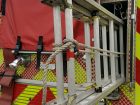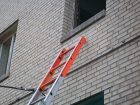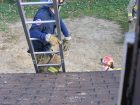
Features
Training
Back to Basics: Tips for proper ground ladder use
I have been focusing a lot on fire ground operations lately after witnessing many firefighters completing tasks in a manner that is inconsistent with their training over the last few months. One area where I have noticed inconsistencies is the use of ground ladders. This area is neglected greatly in the fire service because we often consider ground ladders to be bulky, heavy and awkward to handle.
November 22, 2017
By Mark van der Feyst
The ground ladder should be viewed as a useful tool and firefighters must become very familiar with its use. Many fire departments don’t have the call volume to support the frequent use of a ground ladder, but regardless, all firefighters should train in the event they need to use one.
I want to highlight some useful tips that we can employ when using ground ladders so that no matter the department or the firefighter, ground ladders can be easily integrated into operations.
The first tip concerns the halyard. The halyard needs to be tied in a manner that allows one firefighter to raise and extend the ladder, without having to untie the halyard. This can be accomplished as shown in photo 1. Tie the halyard around the bottom rung of the bed section using a clove hitch, and ensure it is kept this way. When it comes time to extend the fly section of the ladder, all you need to do is pull on the halyard. The ladder should extend easily when the halyard is tied this way. I have seen too many firefighters wasting time by untying and retying the halyard once the ladder has been raised into position.
Even if the halyard is not tied around the rungs after the ladder has been raised, the ground ladder will still work safely. The halyard is not the safety feature that prevents the fly section from sliding back down; the pawls or dogs are rated for that exact purpose. If the dogs or pawls are secured around the rung, this means the fly section is secured in position. If the pawls are not engaged, the fly section will slide back down.
The second tip is to identify the middle of the ground ladder. Paint a truck number on the side of the beam or use a certain colour to mark the middle of the ground ladder. Your department can use any colour for this marker, but the most common are green and red. The marker serves a bigger purpose than just telling you which truck the ladder belongs to — it tells the firefighter where to grab the ladder when picking it up from the ground, or where to shoulder the ladder when sliding it off the truck. This allows the firefighter to find the right spot to shoulder the ladder easily, avoiding having the ladder teeter-totter on their shoulder. Knowing where to grab the ladder allows for more efficient and effective operations.
The third tip is to orientate ground ladders to be ready for deployment right from the truck. As seen in photo 1, the ground ladder is mounted in the truck with the butt spurs facing the right direction, or the direction of travel. I have seen ground ladders mounted with the butt spurs facing the wrong direction, making deployment less efficient and more difficult for the firefighter. Firefighters should be able to open the compartment door, grab the ladder, pull it off onto their shoulder and continue moving in the same direction. If the ground ladder is mounted on the side of the truck, the application is the same. Have the butt spurs facing the direction of travel, which will be usually the rear of the truck.
The fourth tip is to paint the tips of the ladder to identify where the ladder will sit at the roofline. As you can see in photo 2, the tip of the ladder has been painted bright orange, which allows for better visibility. Notice how far down the paint goes – it covers about three rungs, which is the minimum number of rungs required to sit above a roofline based on industry standards. When a firefighter needs to locate the ground ladder while on the roof, they simply need to look for the orange painted tips. Fluorescent glow-in-the-dark paint can also be used for nighttime operations.
The fifth tip is to always go more than three rungs above the roofline. The general rule of thumb is to have the rungs of the ladder to be at least three rungs above the roof but no more than five rungs. Why not always go with five rungs all the time as depicted in photo 3? Having five rungs above the roofline makes the ladder much more visible, easier for the firefighter to get on and off of the ladder and allows for more control for the firefighter.
The final tip is to always place the tip of the ladder at the window ledge or windowsill. Whenever laddering a window for the purpose of rescue, gaining entry, breaking a window, applying water through the window, or any purpose, the best place for the ladder tip is always at the windowsill. Some textbooks overthink ladder operations, showing different ways to ladder a window based upon the assigned task, without taking the firefighter’s greatest need into consideration – self rescue and occupant rescue. If the tip of the ladder is placed at the windowsill, the ladder will be in the right position should a firefighter need to bail out of a building using a ladder dive. Alternatively, if the firefighter needs to remove an occupant through the window, the ladder will be in the right position.
Armed with these tips, firefighters are able to use ground ladders effectively and efficiently. Keep in mind, these tips are only suggestions that can be improved or modified to accommodate situational requirements. But remember, training is the key to perfecting ground ladder operations.
Mark van der Feyst has been a member of the fire service since 1999 and is a full-time firefighter in Ontario. Mark teaches in Canada, United States and India, and is a FDIC Instructor. He is the lead author of the Residential Fire Rescue book. Email Mark at Mark@FireStarTraining.com
Print this page
Advertisement
- Mapping the crisis: Department tracks overdoses in real-time
- Scars vs. Scabs: The differences between PTSD and other mental health issues


